Planning to visit Pompeii, but not sure where to start? You’ve come to the right place!
Pompeii is a huge archaeological site, covering over 12 km squared. With so much to see and do in Pompeii, planning a visit there can be daunting.
After all, how do you decide what to see in Pompeii? Which ruins are the most important and significative ones? What parts of this ancient city you absolutely can’t miss?
In this article, I will tell you just that! Including a map of the Pompeii ruins, and details of all the best spots to visit, this article will help you make the most of a self-guided tour of Pompeii.
So what are you waiting for, let’s dive in, and start planning the perfect Pompeii trip!
Contents
- 1 What is Pompeii
- 2 Can you visit Pompeii without a tour?
- 3 Map of Pompeii ruins
- 4 What to see in Pompeii
- 4.1 Park at Parking Zeus & start at Porta Marina
- 4.2 Sanctuary of Apollo
- 4.3 Foro di Pompeii
- 4.4 House of the Faun
- 4.5 Lupanare di Pompeii
- 4.6 Terme Stabiane
- 4.7 Teatro Grande
- 4.8 Gladiator Barracks
- 4.9 House of Menander
- 4.10 House of Ceii
- 4.11 Garden of the Fugitives
- 4.12 Amphitheatre of Pompeii
- 4.13 House of Venus in the Shell
- 5 Best Pompeii tours
- 6 Where to stay to visit Pompeii
- 7 What to pack for Pompeii
- 8 Do you need travel insurance to visit Pompeii?

Unique views of Pompeii and Mount Vesuvius in Italy

Columns of the Foro di Pompeii framing Mount Vesuvius in the background
What is Pompeii
The ruins of Pompeii are what remains of a once bustling Roman city in the Bay of Naples, southern Italy. It was a busy trading port with a population of around 20,000.
A fully-fledged city, it boasted an amphitheatre, a forum, baths, temples, and public fountains. There were even holiday villas in the suburbs.
But in the year 79 AD, the nearby Mount Vesuvius erupted, creating a catastrophic event that rained down volcanic ash and pumice across the area. Temperatures rose to an incredible 300 degrees.
Those who didn’t flee were killed and buried in 6 metres of ash that erased the city. It was all written down by Roman historian Pliny the Younger.
Fast-forward to 1594, and the ruins were discovered thanks to excavations by architect Domenico Fontana, who stumbled across them by chance.
In 1748, proper excavations of Pompeii, Italy, began. Today Pompeii is a UNESCO World Heritage Site. Amazingly, new finds are still being uncovered here.
It’s a must-see on many Italy itineraries and bucket lists, and it’s easy to see why.
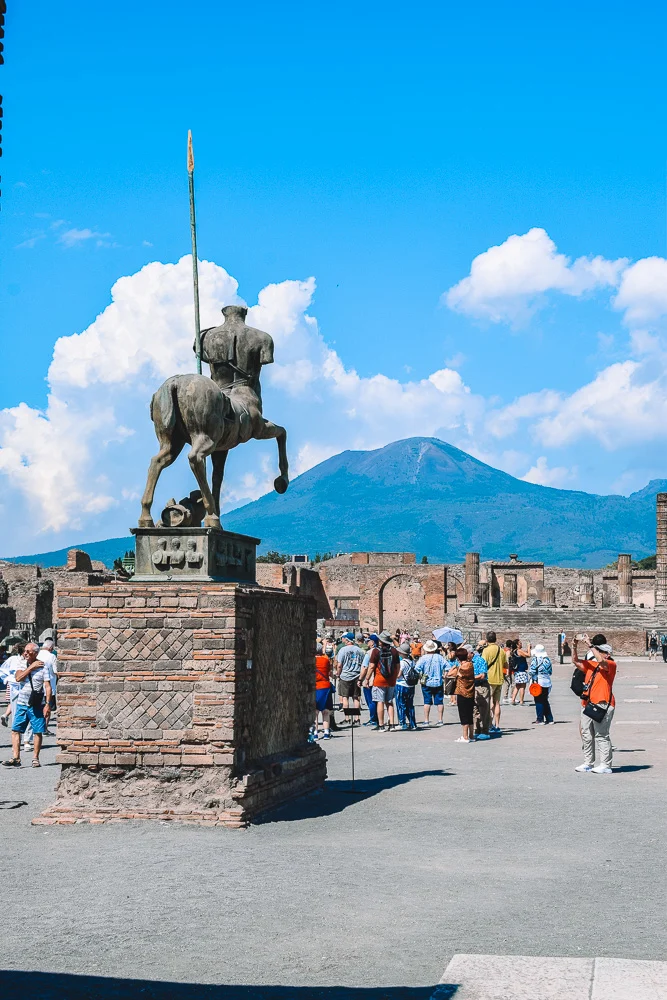
View of the Centauro di Igor Mitoraj, the Foro di Pompeii and Mount Vesuvius in the background
Can you visit Pompeii without a tour?
Yes, it is possible to visit Pompeii without a guide, and it’s actually what we did on our last visit.
However, I wouldn’t say that it’s the best way to visit Pompeii. It’s much better to visit Pompeii with a local guide, as they will take you to all the best ruins, and tell you everything about them.
A knowledgeable guide will give you all the important historical facts and anecdotes that you just wouldn’t know otherwise, plus also show you some lesser-known or off-the-beaten-track sights.
Given the size of the archaeological site (it’s absolutely huge; they’re still excavating it), it’s really not a good idea to go in without any prior knowledge at all.
Otherwise, you’ll just be wandering aimlessly around the 170-acre site without knowing the best parts of the Pompeii ruins. Which is pretty much what we did.
Click here to book your guided tour of Pompeii!
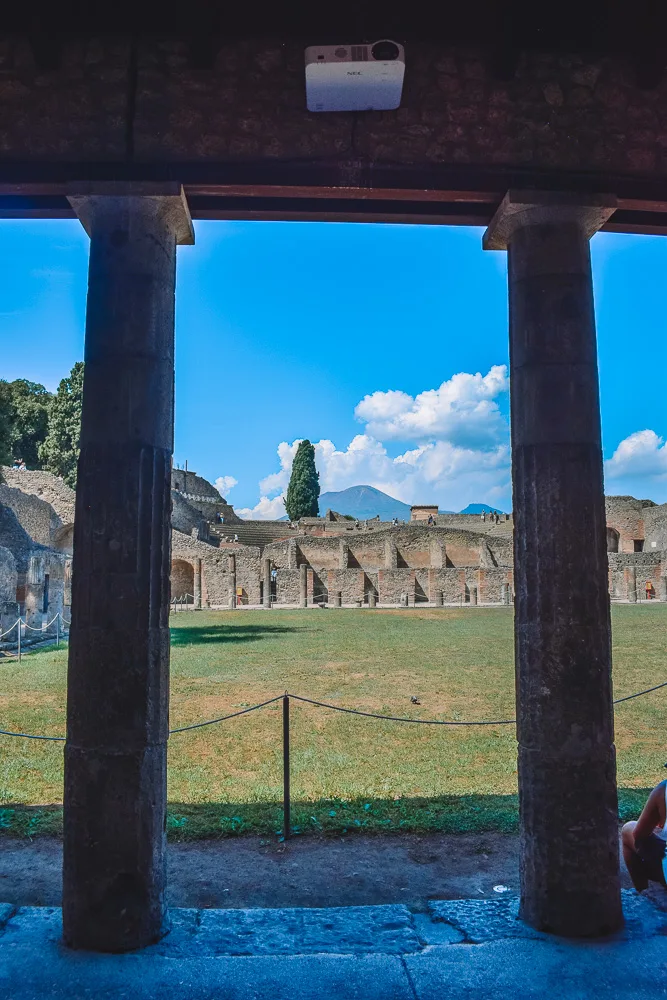
Mount Vesuvius as seen from the Gladiator Barrack’s of Pompeii
After entering Pompeii and realising just how big it was, we started wandering around aimlessly, and then hiding in the little shade provided by Ancient Roman columns during a hot Italian summer, trying to Google on our phones where to go within the site.
Don’t be like us, and book yourself a guided tour around Pompeii with an archaeologist like this one, and save yourself the headache.
That said, that’s not to say you can’t go on a self-guided tour of Pompeii. We did after all, and it was still a very enjoyable day.
So if you’re interested in knowing the best ruins to visit on a DIY walking tour of this ancient site, here’s what to see in Pompeii ruins.
Don’t miss out, check out prices & availability for your Pompeii tour with an archaeologist here!
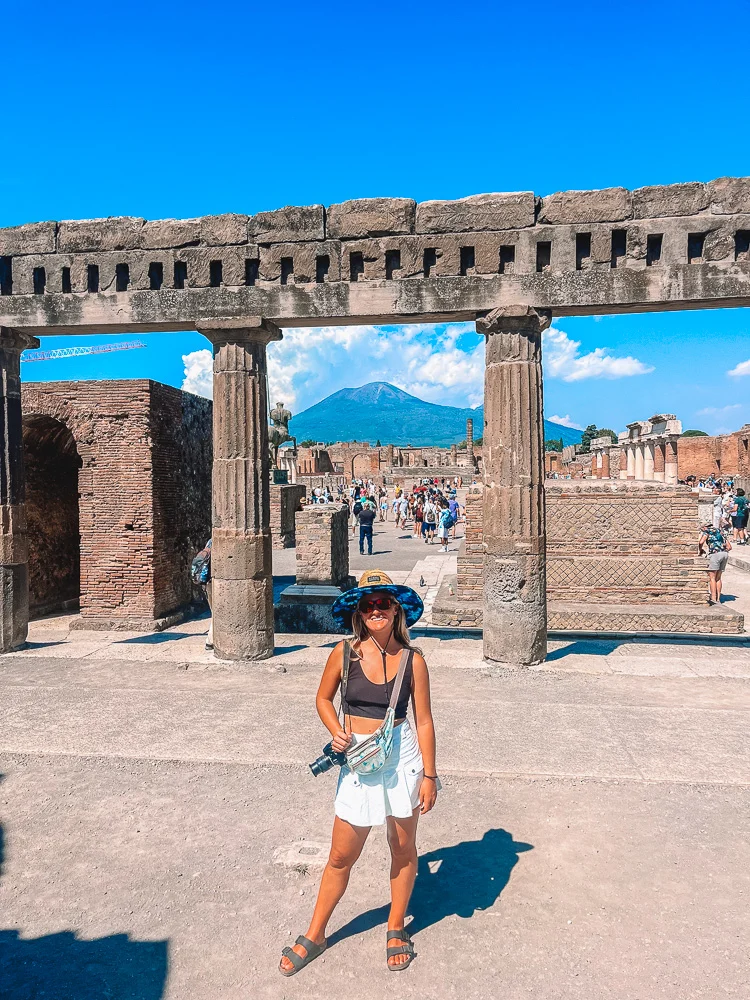
Tourist mode on while exploring Pompeii in Italy
Map of Pompeii ruins
Before we jump into the details of the most important ruins to visit in Pompeii, it’s good to see a map of where the ruins are in the archaeological site.
The Pompeii archaeological site covers an area of 163 acres, and there are loads of ruins within that. In the map below I’ve marked the best preserved, most interesting or most historically significant ruins of Pompeii.
I’ve also marked in yellow Parking Zeus and the Porta Marina entrance, so you can easily see where to start your Pompeii self-guided tour.
What to see in Pompeii
Here are some of the top Pompeii attractions to see on your DIY visit to this relic of ancient Rome.
Park at Parking Zeus & start at Porta Marina
My tip is to start your trip at Parking Zeus and then head to the nearest entrance. Go to the official entrance gates to buy tickets (not from the sellers outside!), or purchase them online beforehand.
On the short walk from Parking Zeus to the Pompeii Entrance you will come across at least two different ticket resellers.
While they will still get you into Pompeii, these aren’t official tickets, and are usually 2-3 EUR more than the official Pompeii ticket price.
At the main entrance and official ticket office you can also pick up a map of the Pompeii ruins, and also hire a guide if you’re not feeling up to exploring the site alone.
After the ticket entrance you will walk through Porta Marina, and officially enter the Pompeii archaeological park.
Skip the line, and book your Pompeii fast track ticket here!

Entering the archaeological site of Pompeii from Porta Marina
Sanctuary of Apollo
Start your list of places to visit in Pompeii with the Temple of Apollo. Dating back to 120 BC, it’s dedicated to the Roman deity Apollo, and is one of the oldest religious buildings in the city.
There’s evidence that shows that a temple has been on this site as far back as the 6th century BC.
Its location is particularly important, being situated on the path that leads to the Marina Gate – the route into the centre of the city.
Today not much remains except for some columns still standing, as well as steps and ruined walls. Mount Vesuvius is easily visible from here.
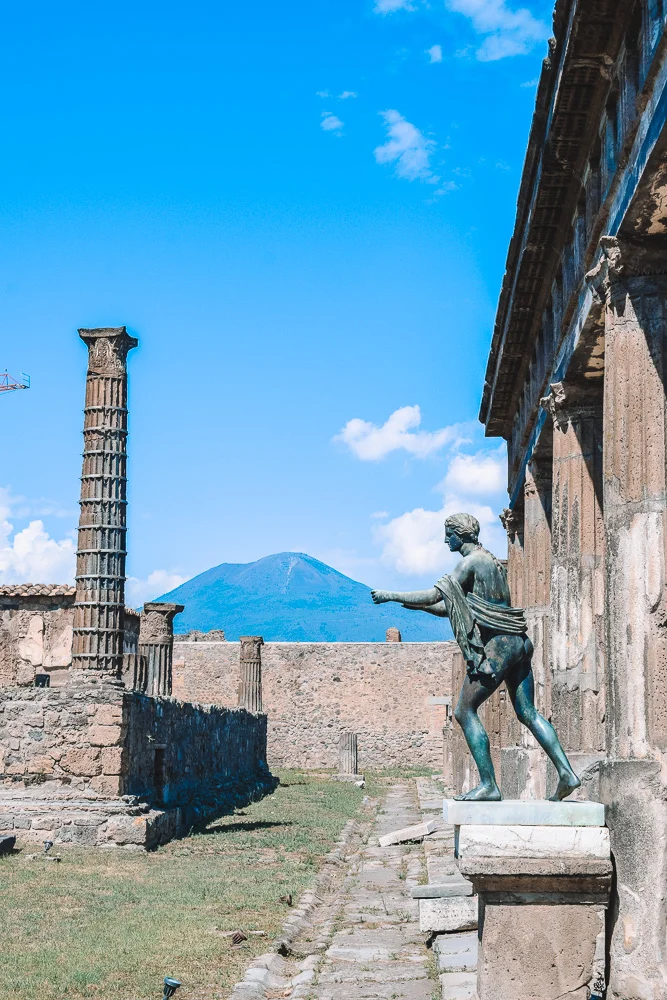
The Santuario di Apollo in Pompeii with Mount Vesuvius in the background
Foro di Pompeii
Close by is the Foro di Pompeii, or the Forum of Pompeii. The Foro is one the best things to see in the Pompeii ruins, not least for its importance.
This would have once been the centre of public life in the city. All sorts of activities would have taken place here: markets, administration, speeches, and gatherings for festivals.
There would have been important buildings lining the Fourm, including bathhouses, theatres, and a basilica, to name a few.
Between the 3rd and 2nd centuries BC, the Roman Forum was renovated with new paving slabs and porticoes. Standing there today you can imagine the people of Pompeii gathering and going about their daily errands.

The Foro di Pompeii with Mount Vesuvius in the background

Exploring the Foro di Pompeii
House of the Faun
Follow your ruins of Pompeii map to the House of the Faun. This is a Pompeii must-see and one of the most popular places to visit in the whole site.
Dating back to the 2nd century BC, it was the most lavish villa in the city and covered an area of 3,000 square metres.
Today it lies in ruins, of course, but there are traces of its former elegance still visible. The layout, for one thing, is still intact, so you can see the sheer scale of the place.
Many interesting artworks were uncovered here, but they are in the National Archaeological Museum of Naples.
At the centre of the villa, you’ll find a copy of the statue of a faun (a half-deer, half-human creature) that was found here, which gives the villa its name.
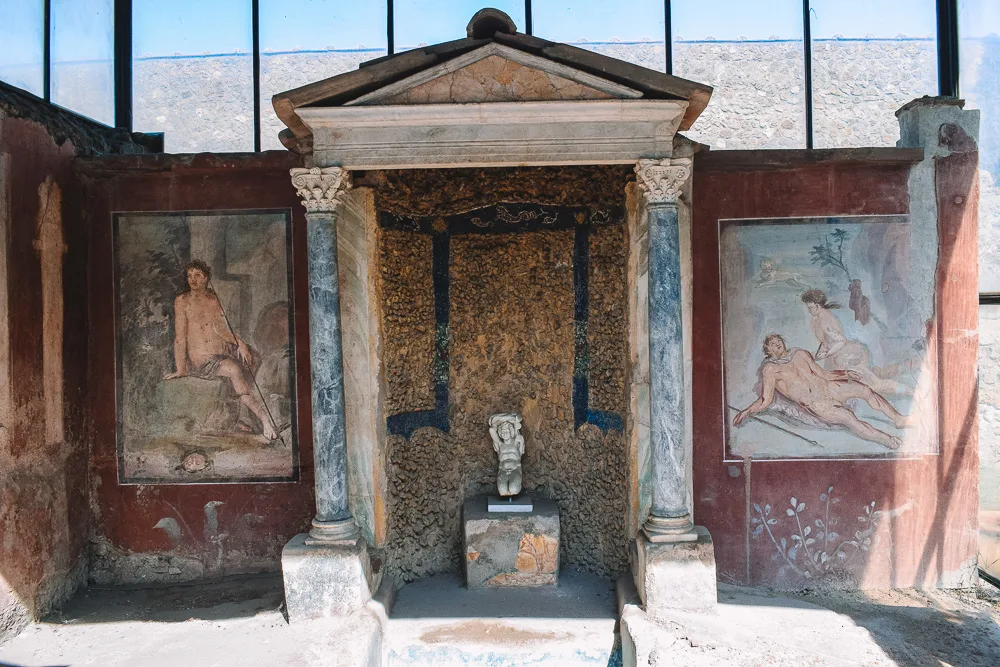
Some of the beautiful affresco paintings in Pompei
Lupanare di Pompeii
Amongst the most infamous highlights of Pompeii is the Lupanare, or brothel, which you’ll find two blocks or so from the Forum.
Pompeii was closely associated with Venus, the Roman goddess of sex and love, and so there were once actually many brothels located in Pompeii.
This one was the largest, featuring 10 rooms that were simply furnished with a mattress placed on a raised brick platform.
One of the most interesting things about this place is the wall paintings and erotic art that has been found decorating the walls of the brothel.
Pompeii was a naval city, with ships from all over the Mediterranean docking here. Not all sailors spoke Latin, therefore the walls of brothels were covered in erotic paintings, so that sailors could point to the service they wanted.

Exploring the Santuario di Apollo in Pompeii, Italy
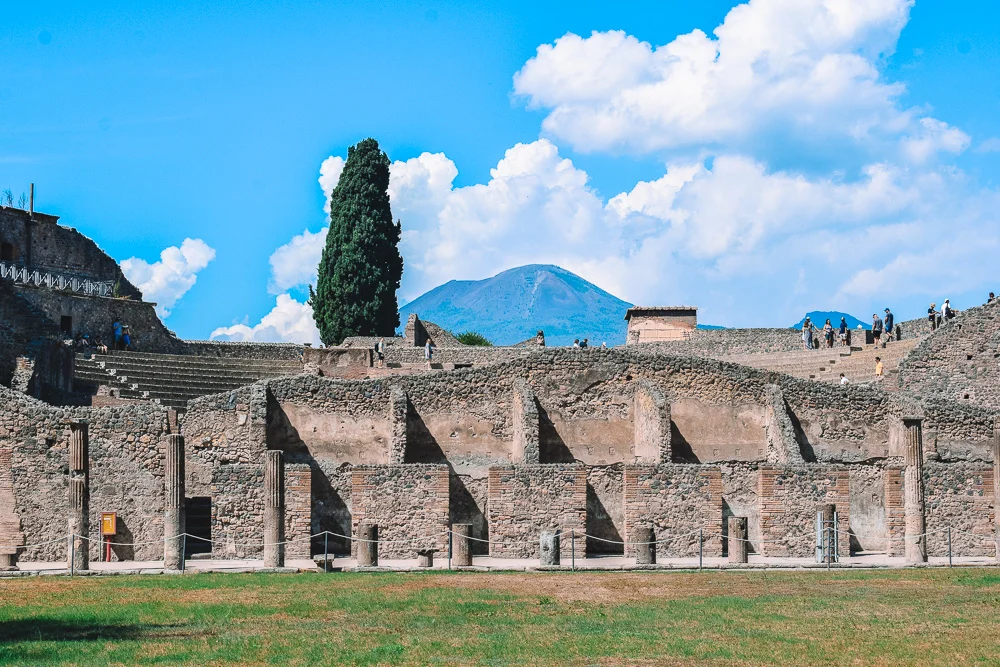
Exploring the Gladiator Barracks at the Quadriportico dei Teatri in Pompeii, with Mount Vesuvius in the background
Terme Stabiane
Not far from the Lupanare is the impressive Terme Stabiane. These baths are the biggest and oldest of the five bath complexes that once dotted Pompeii.
Dating back to 125 BC, the Stabian Baths are actually one of the oldest surviving examples of ancient public baths.
Different areas are still discernable today, such as the changing rooms, the tepidarium, the frigidarium and caldarium.
There’s even the remains of a swimming pool, and you can still see the sign for the male and female entrances.

The Terme Stabiane in Pompeii, Italy
Teatro Grande
The Theatre of Pompeii was the largest theatre in the city. Built in the 2nd century BC, it had enough room for around 5,000 people to sit in its stands.
In fact, it was the first stone theatre to be built in the Roman world, so seeing it is definitely one of the best things to do in Pompeii. It’s literally a slice of theatre history.
Making up other parts of the building is the odeon, a smaller theatre built in 80 BC with room for around 1,500 people. Don’t miss the Quadriporticus, which was used by the audience to walk between events.

Exploring the Teatro Grande of Pompeii

Exploring the Teatro Grande of Pompeii with Mount Vesuvius in the background
Gladiator Barracks
The Gladiator Barracks was the centre of gladiatorial life in Pompeii. The complex was used for training gladiators and features a Quadriporticus, too, just like the Teatro Grande.
There are various inscriptions on the walls, which illustrate not just everyday life for gladiators but also mythological and hunting scenes.

Exploring the Gladiator Barracks at the Quadriportico dei Teatri in Pompeii
House of Menander
The House of Menander showcases how the elite citizens of Pompeii lived. Once home to a very wealthy family, and set in what was a business area of the city, this impressive townhouse covers an area of 1,800 square metres.
It was an expression of status and featured a whole lot of luxury – think Corinthian columns, gardens, and sumptuous frescoes.
Interestingly, the house was actually undergoing renovations during the time of the eruption of Mount Vesuvius.
Archaeologists know this because precious items such as silverware were in storage, and there were only a few household staff on duty at the time.

The beautiful courtyard of House of Menander in Pompeii, Italy

House of Ceii
It’s believed that the House of Ceii belonged to a wealthy magistrate called Lucius Ceius Secundus. The house is smaller in size than that of Menander or the Casa del Fauno, but is still luxuriously decorated.
Here you’ll be able to see eye-catching frescoes in the garden; these depict landscapes, hunting scenes, Egyptian themes (including a depiction of the River Nile), and wild beasts.

The beautiful paintings and affrescos of Casa dei Ceii in Pompeii, Italy
Garden of the Fugitives
The Garden of the Fugitives is one of the most important things to see in Pompeii. Here you can see the final resting places of 13 unfortunate inhabitants of the city, who were killed trying to flee the cataclysmic eruption.
At the time, the area was a vineyard where people would gather for banquets. The casts of 13 victims of the volcanic eruption can be seen encased in glass close to the back wall of the garden.

The Garden of the Fugitives in Pompeii, Italy
Amphitheatre of Pompeii
Dating back to 70 BC, the Amphitheatre of Pompeii is actually the oldest surviving Roman amphitheater, and one of the most important relics of the ancient Roman Empire.
It was the site for gladiatorial contests and other large-scale sporting events.
In its heyday, around 20,000 people could be crammed into this venue, which was actually built into the earth itself. It’s up there as the best of Pompeii ruins.
A number of posters and paintings on the walls of the Amphitheatre have offered up an interesting glimpse into events here.
One poster reads “Heart-throb of the Girls”, giving an insight into the pop culture of Pompeii at the time.

The Amphitheatre of Pompeii from the outside

The interior of the Amphitheatre of Pompeii in Italy
House of Venus in the Shell
This first-century BC house had many redecorations and redesigns over the years, but is named after the monumental fresco that decorates one of the walls within.
Here the goddess Venus is depicted nude, wearing a tiara and jewellery whilst reclining in a giant shell.
The house was the property of a prominent family called the Satrii, who were very influential in the latter days of Pompeii.

The beautiful affresco from which House of Venus in the Shell takes its name, in Pompeii, Italy
Best Pompeii tours
If after checking out my map and reading this article, making your way around Pompeii alone feels daunting, here are some great Pompeii tours you can join.
Pompeii: Small Group Tour with an Archeologist – This is one is great if you plan to make your own way to Pompeii, and just want an experienced guide to take you around the archeological site.
Naples or Sorrento: Full-Day Pompeii and Mount Vesuvius Tour – If you’re staying in Naples or Sorrento, this tour is great because it includes also the transfer, as well as a visit to Mount Vesuvius.
From Rome: Pompeii and Mount Vesuvius Day Trip – If your Italy itinerary doesn’t allow for a night around Pompeii and you’re visiting on a day trip from Rome, this tour is the best way to visit Pompeii.
Amalfi Coast: Pompeii, Vesuvius, & Wine Tasting with Lunch – Besides the transfers from/to the Amalfi Coast, this guided tour also includes Mount Vesuvius, lunch and a wine tasting! What more could you ask for?

Admiring the beautiful murals at the House of Venus in the Shell in Pompeii, Italy

Walking down the ancient streets of Pompeii in Italy
Where to stay to visit Pompeii
Even though Naples is closer, I would personally suggest staying on the Amalfi Coast for your Pompeii day trip.
It’s only an hour drive away, and it’s a truly stunning part of Italy. That way you can combine it to a wider Amalfi Coast itinerary, and visit also places like Capri and Positano.
Here are some places for every budget.
Budget: Holidays Baia D’Amalfi – While the words “budget” and “Amalfi Coast” don’t often go together, this hotel is pretty affordable and is located right by the harbour.
Click here to book your stay at Holidays Baia D’Amalfi!
Mid-range: Albergo S. Andrea – This hotel has beautiful views over the Duomo of Amalfi. For an affordable mid-range choice, it doesn’t get much better than this!
Check out prices & availability at Albergo S. Andrea in Amalfi here!
Luxury: Le Sirenuse – This is the luxury hotel in Positano by definition. With its gorgeous design, impeccable service, stunning views and central position, it’s the perfect place to treat yourself.
Click here to book your stay at Le Sirenuse in Positano!
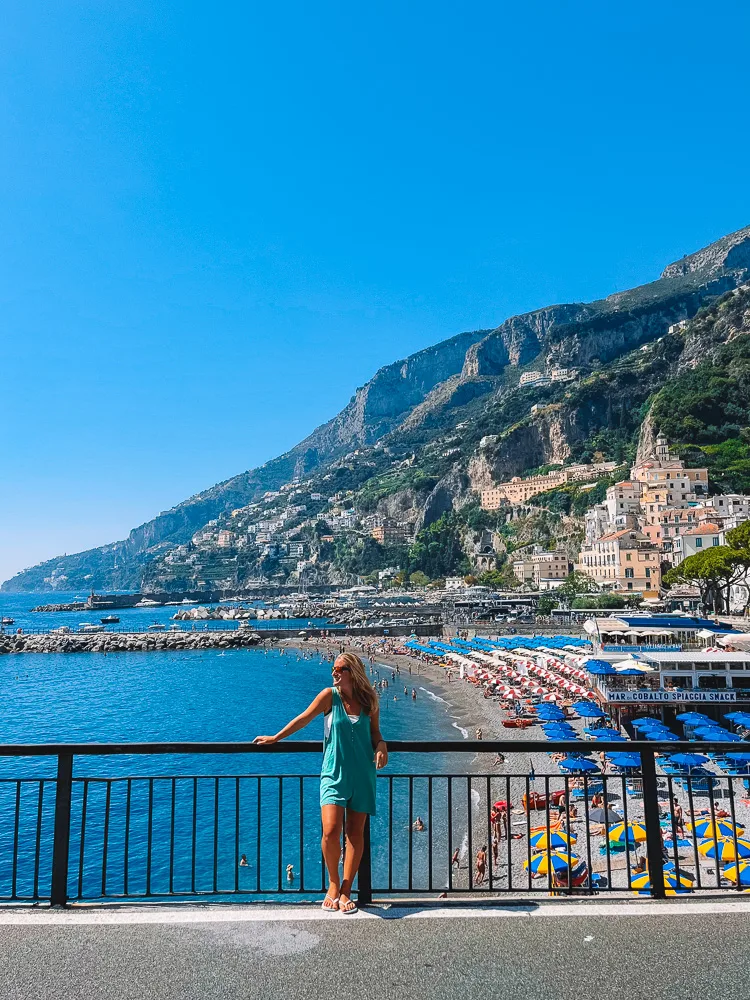
Enjoying the beach, sunshine and views in Amalfi, Italy
What to pack for Pompeii
You don’t need much beyond the usual Italy travel essentials, but just so you don’t forget, here are some of the things I highly recommend packing to visit Pompeii.
Refillable water bottle – There are water fountains where you can refill in Pompeii, so bring a refillable bottle. It’s super hot in the summer months and you should definitely keep hydrated.
Hat – Especially if you visit during the summer months, Pompeii is very hot and there’s virtually no shade. A hat is a must!
Sunblock / sunscreen – With pretty much no shade, getting sunburnt is a possibility if you don’t cover up or wear sunscreen. And it’s not fun being sunburnt!
Sturdy, comfortable shoes – There’s a lot of walking around to do on a day trip to Pompeii, and with uneven cobbled roads everywhere, you’ll want some comfortable, sturdy shoes. Hiking sandals would work if that’s what you prefer.
Guidebook – In case you do opt for the DIY tour of Pompeii, I really recommend bringing along a relevant guidebook. Otherwise, you’ll find it difficult to appreciate (or even work out) what it is you’re looking at.
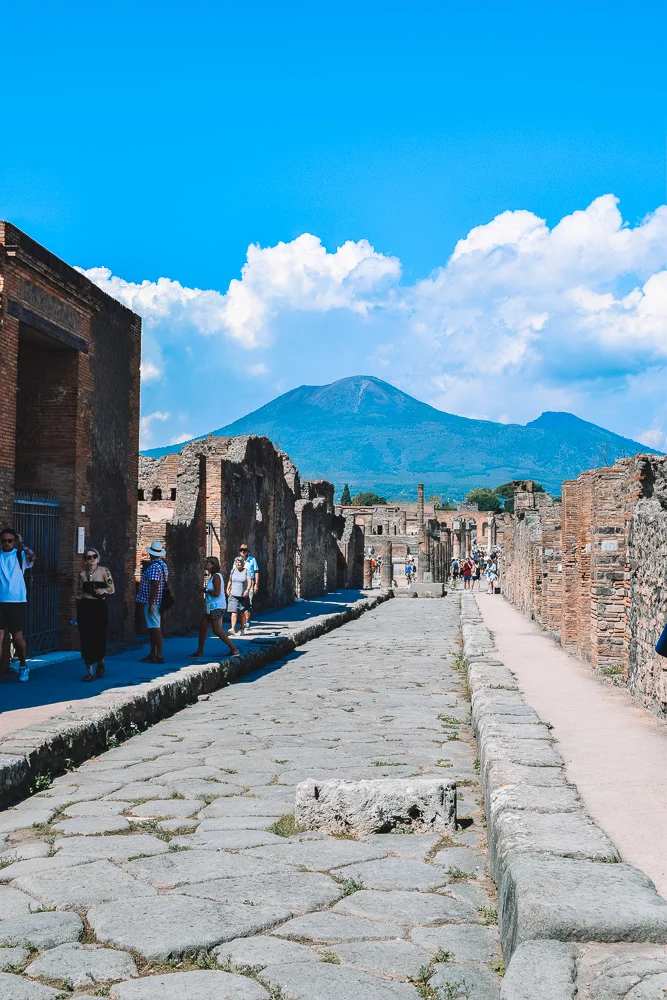
Walking down the cobbled streets of Pompeii, Italy
Do you need travel insurance to visit Pompeii?
After my personal experience spending two nights in a private hospital in Tenerife, and having to pay for it out of pocket (it wasn’t cheap), I always recommend getting travel insurance.
You might not end up needing it, but for a small fee you can travel without worries. Personally, I suggest getting your Italy travel insurance with Heymondo.
Heymondo offers tailor made travel insurance, providing the best value for money for your specific trip. You can also buy it once you’re already abroad and have forgotten about it before flying (which, if you’re anything like me, is quite likely).
Besides the usual cancellation, medical expenses, luggage coverage and general travel insurance services, Heymondo also has a 24/7 doctor chat and instant assistance through their app.
As a Greta’s Travels reader, you get 5% off your Heymondo travel insurance!
Click here to get your 5% off Heymondo travel insurance!

The Foro di Pompeii with Mount Vesuvius in the background
Final thoughts on what to do in Pompeii
There you have it, the ultimate guide on what to see in Pompeii! Have you visited Pompeii before? How did you find it? Let me know in the comments below!
This was my third time visiting Pompeii, and it’s the time that I appreciated it the most. I’d previously visited on school trip as a pre-teen, and on a family trip as a teenager.
While I wouldn’t say I didn’t enjoy it back then, I would say that I definitely didn’t appreciate the vastness and importance of this unique historical site. It’s not every day you can visit such a well preserved Ancient Roman city!
Alongside our private sunset boat tour in Positano, hiking the Path of the Gods and our boat trip in Capri, it was one of the highlights of our time in Amalfi Coast.
It might not have the same buzz that other Italian destinations like Lake Como, Cinque Terre, Florence, Matera or Venice receive, but it’s still pretty unique and incredible.
I hope you found my Pompeii guide useful, and that it helped you figure out what to see in Pompeii. If you have any questions, just let me know in the comments below!
Enjoyed reading about the best ruins to see in Pompeii? Pin it!


